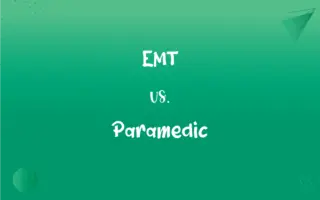GAP vs. GEF: What's the Difference?
Edited by Aimie Carlson || By Janet White || Published on March 12, 2024
GAP is a family of proteins that regulate GTPase activity by promoting the hydrolysis of GTP, whereas GEFs are proteins that activate GTPases by encouraging the exchange of GDP for GTP.

Key Differences
GAPs (GTPase-activating proteins) accelerate the conversion of GTP to GDP, effectively turning off GTPase signals, while GEFs (Guanine nucleotide Exchange Factors) facilitate the exchange of GDP for GTP, turning on these signals. This fundamental difference highlights their opposing roles in cellular signaling pathways.
The action of GAPs ensures that GTPases are in their inactive GDP-bound state more quickly, serving as a braking mechanism in signal transduction. In contrast, GEFs remove GDP, allowing GTP binding, which is akin to pressing the gas pedal in signaling activities.
By regulating GTPase activity, GAPs maintain the balance of cellular processes, preventing overactivation. GEFs, on the other hand, ensure that GTPases can respond swiftly to activation signals, promoting dynamic changes in cell behavior.
GAPs and GEFs are critical for the precise control of numerous cellular functions, including cell growth, differentiation, and movement. Their interplay ensures that cells can rapidly and reversibly respond to internal and external cues.
Both types of proteins exhibit specificity for different GTPases, indicating a highly regulated system of control over GTPase signaling. This specificity ensures that signaling pathways are finely tuned according to cellular needs and environmental conditions.
ADVERTISEMENT
Comparison Chart
Function
Promotes GTP hydrolysis to GDP
Facilitates GDP/GTP exchange
Role in Cell Signaling
Acts as an off switch
Acts as an on switch
Effect on GTPase Activity
Decreases activity by accelerating GTP hydrolysis
Increases activity by promoting GTP binding
Impact on Cellular Processes
Prevents overactivation of signaling pathways
Enables rapid response to activation signals
Specificity
Specific to certain GTPases
Specific to certain GTPases
ADVERTISEMENT
GAP and GEF Definitions
GAP
GAPs are enzymes that inactivate GTP-binding proteins by accelerating the hydrolysis of GTP.
RasGAP regulates the Ras signaling pathway by increasing the hydrolysis of GTP.
GEF
They initiate signal transduction pathways.
GEF-mediated activation of Rac1 leads to cell migration.
GAP
Their activity is regulated by other cellular factors.
Kinase-mediated phosphorylation can modulate GAP activity towards its substrate GTPases.
GEF
Their activity can be regulated by phosphorylation.
Phosphorylation of GEFs can enhance their ability to activate GTPases.
GAP
GAPs are critical for cellular homeostasis.
GAP dysfunction is implicated in various diseases, including cancer.
GEF
GEFs are pivotal for responding to extracellular signals.
Cellular responses to growth factors often involve GEF activation.
GAP
They ensure timely termination of signal transduction.
Without GAP, prolonged signal transduction could lead to uncontrolled cell growth.
GEF
Each GEF is specific to certain GTPases.
Vav1 is a GEF that specifically activates the Rho family of GTPases.
GAP
Specific GAPs target specific GTPases.
RhoGAP specifically inactivates Rho GTPases, regulating cell morphology.
GEF
GEFs activate GTP-binding proteins by facilitating the exchange of GDP for GTP.
GEFs activate Rho GTPases, promoting changes in the actin cytoskeleton.
FAQs
How do GEFs activate GTPases?
GEFs promote the exchange of GDP for GTP on GTPases, thereby turning on signaling pathways.
What role do GAPs play in disease?
Dysregulation of GAP activity can lead to diseases, including cancer, by affecting cellular signaling pathways.
How do external signals influence GEF activity?
External signals can activate GEFs, leading to the activation of GTPases and initiation of signaling pathways.
Can mutations in GAPs or GEFs lead to disease?
Yes, mutations that alter the activity of these proteins can disrupt normal cellular signaling and lead to diseases.
What happens if GAP activity is too high?
Excessive GAP activity can suppress necessary signaling pathways, potentially impairing cell function.
How does the specificity of GAPs and GEFs affect cell signaling?
The specificity ensures that signaling is precisely controlled, allowing cells to respond appropriately to various stimuli.
Can GAP and GEF target the same GTPase?
Yes, GAPs and GEFs can target the same GTPase, providing a means to finely control its signaling activity.
Are GEFs involved in cellular movement?
Yes, GEFs play a crucial role in cellular movement by activating GTPases that regulate the cytoskeleton.
How are GAPs and GEFs studied in the lab?
They are studied through biochemical assays, genetic manipulation, and imaging techniques to understand their roles in signaling.
What is the main function of GAP?
GAPs inactivate GTP-binding proteins by accelerating GTP hydrolysis, turning off signaling pathways.
What factors regulate the specificity of GAPs and GEFs towards GTPases?
Structural compatibility and regulatory mechanisms ensure that GAPs and GEFs specifically interact with target GTPases.
Can GEFs be targeted for therapeutic purposes?
Yes, targeting GEFs offers a strategy for modulating signaling pathways in diseases like cancer.
How do cells regulate GAP and GEF activity?
Cells regulate these activities through various mechanisms, including phosphorylation and interaction with other proteins.
Do GAPs and GEFs work independently?
While they have distinct functions, their activities are coordinated within the cell to ensure proper signaling.
What is the importance of GTP hydrolysis in cell signaling?
GTP hydrolysis is a crucial step that ensures the temporally controlled inactivation of GTPase signals.
How do GAPs and GEFs contribute to cellular differentiation?
They regulate signaling pathways that are essential for the processes of cellular growth and differentiation.
How do mutations in GTPases affect GAP and GEF function?
Mutations in GTPases can alter their responsiveness to GAP and GEF, impacting signaling pathways.
What is the consequence of dysregulated GEF activity?
Dysregulated GEF activity can lead to abnormal activation of signaling pathways, contributing to disease progression.
Is there a feedback mechanism involving GAPs and GEFs?
Feedback loops can exist where the activity of GTPases, modulated by GAPs and GEFs, regulates downstream effects that can influence GAP and GEF expression or activity.
Can the activity of GAPs and GEFs be measured in living cells?
Yes, using fluorescent biosensors and other imaging techniques, the activity of these proteins can be visualized and measured in living cells.
About Author
Written by
Janet WhiteJanet White has been an esteemed writer and blogger for Difference Wiki. Holding a Master's degree in Science and Medical Journalism from the prestigious Boston University, she has consistently demonstrated her expertise and passion for her field. When she's not immersed in her work, Janet relishes her time exercising, delving into a good book, and cherishing moments with friends and family.
Edited by
Aimie CarlsonAimie Carlson, holding a master's degree in English literature, is a fervent English language enthusiast. She lends her writing talents to Difference Wiki, a prominent website that specializes in comparisons, offering readers insightful analyses that both captivate and inform.






































































